Family: Siricidae
Subfamily: Siricinae
Genus: Sirex Linnaeus, 1760
Species: Sirex ermak (Semenov, 1921)
Common names: blue-black horntail
Sirex ermak is a completely dark species known from eastern Russia (Smith 1978Smith 1978:
Smith DR. 1978. Suborder Symphyta (Xyelidae, Parachexyelidae, Parapamphiliidae, Xyelydidae, Karatavitidae, Gigasiricidae, Sepulcidae, Pseudosiricidae, Anaxyelidae, Siricidae, Xiphydriidae, Paroryssidae, Xyelotomidae, Blasticotomidae, Pergidae). Hymenopterorum Catalogus 14: 1-193., EPPO 2005EPPO 2005:
EPPO 2005. Sirex ermak . Data sheets on quarantine pests. European and Mediterranean Plant Protection Organization OEPP/EPPO Bulletin 35: 453-455.)
See Sirex for genus-level diagnostic characteristics.
The existing description of Sirex ermak is somewhat incomplete; pit texture and density across most body parts are not recorded.
Females:
 , and legs completely black with metallic reflections (Zhelokhovtsev 1994Zhelokhovtsev 1994:
, and legs completely black with metallic reflections (Zhelokhovtsev 1994Zhelokhovtsev 1994: (EPPO 2005EPPO 2005:
(EPPO 2005EPPO 2005: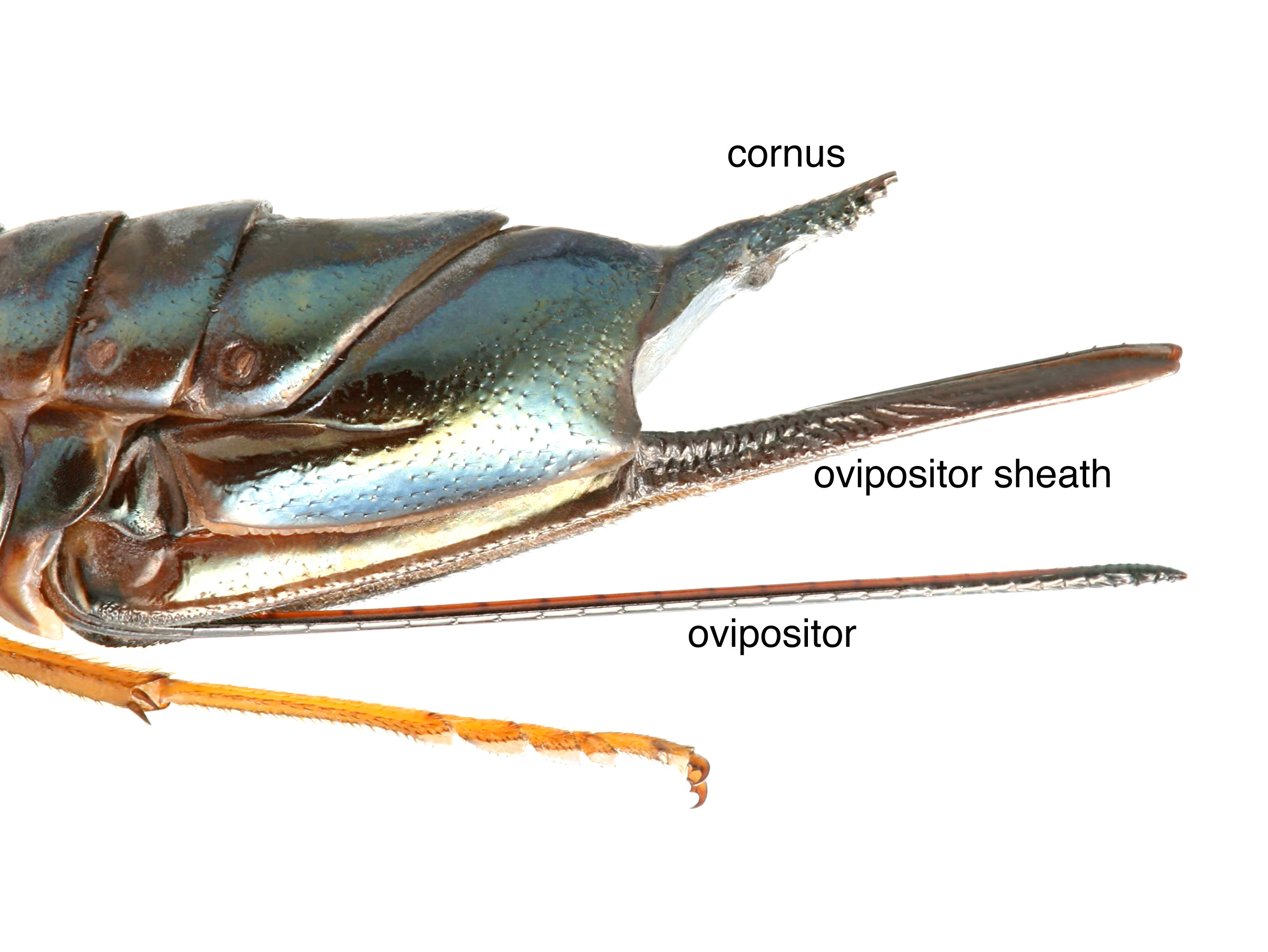 in female slightly longer than the length of the fore wingfore wing:
in female slightly longer than the length of the fore wingfore wing: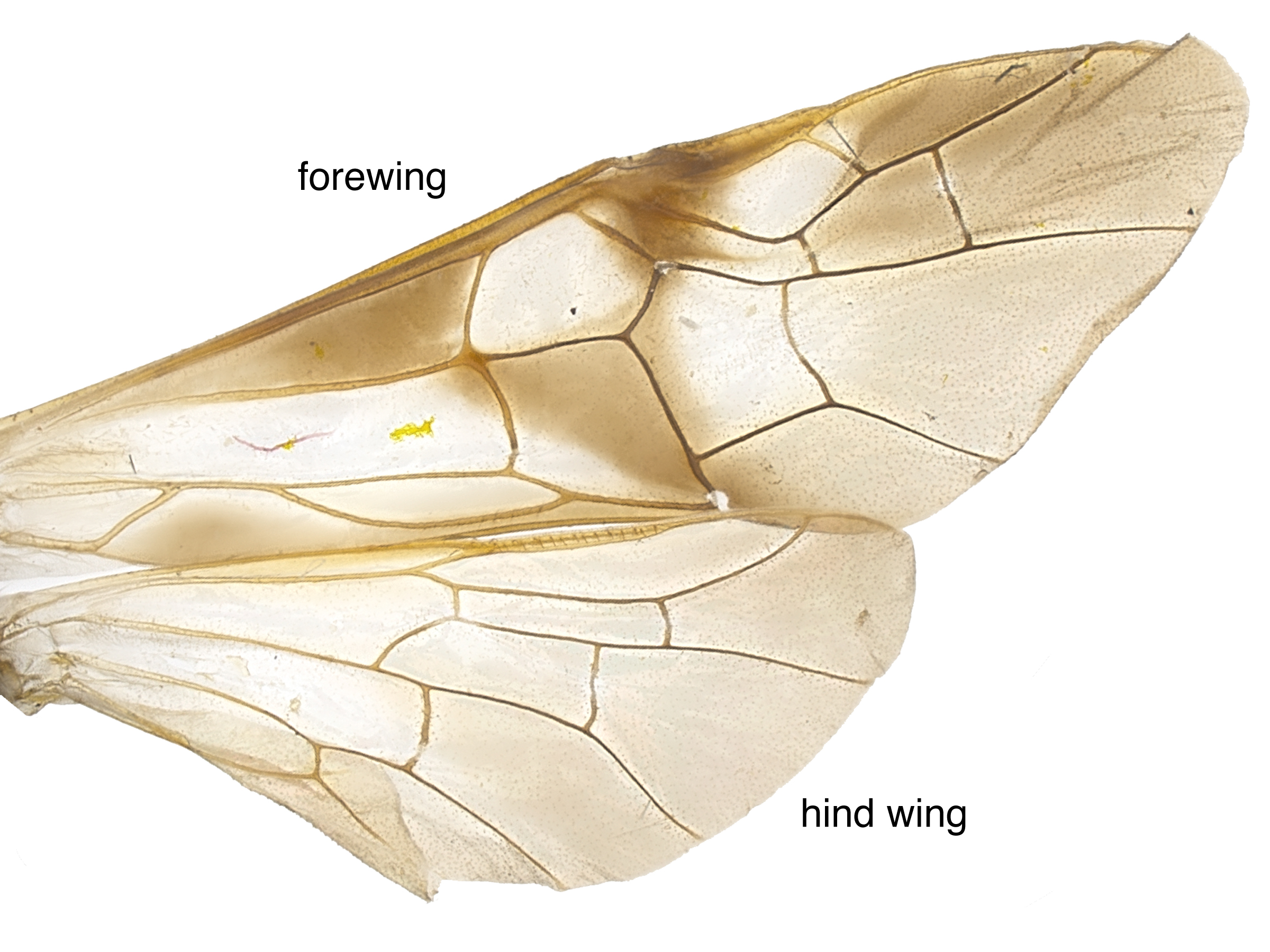 (EPPO 2005EPPO 2005:
(EPPO 2005EPPO 2005:Males:
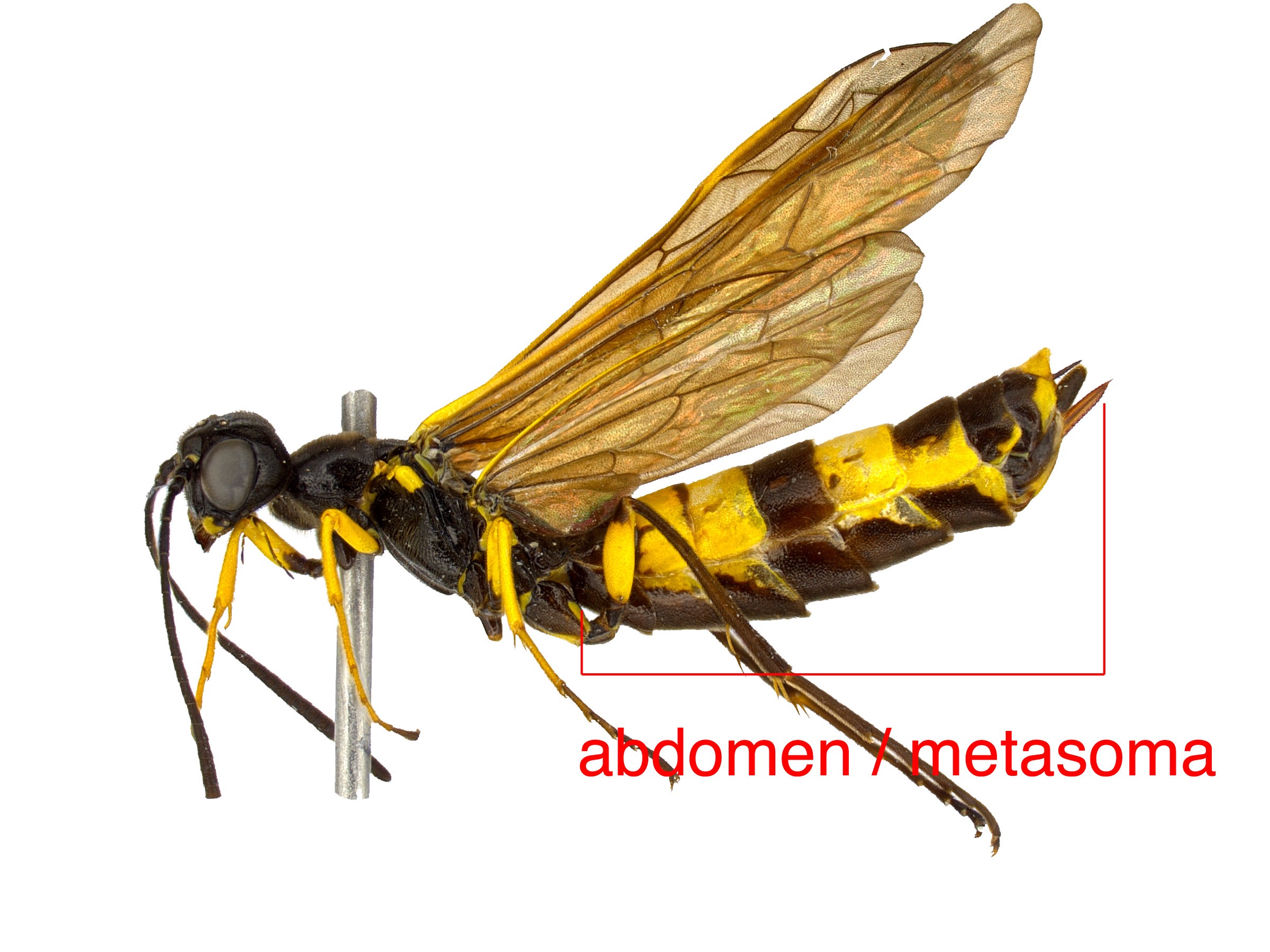 reddish-brown with black on the sternumsternum:
reddish-brown with black on the sternumsternum: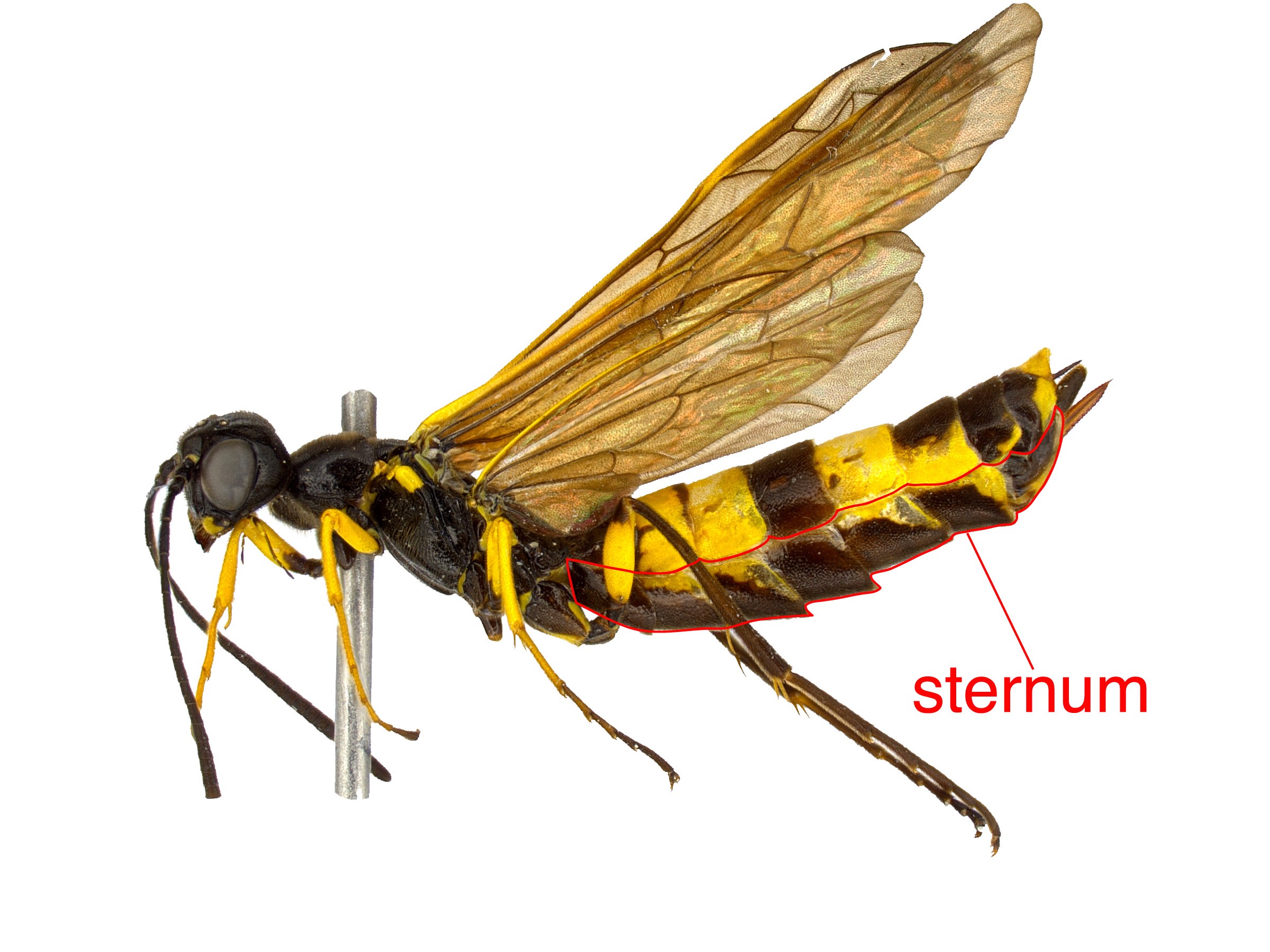 and black apicalapical:
and black apicalapical: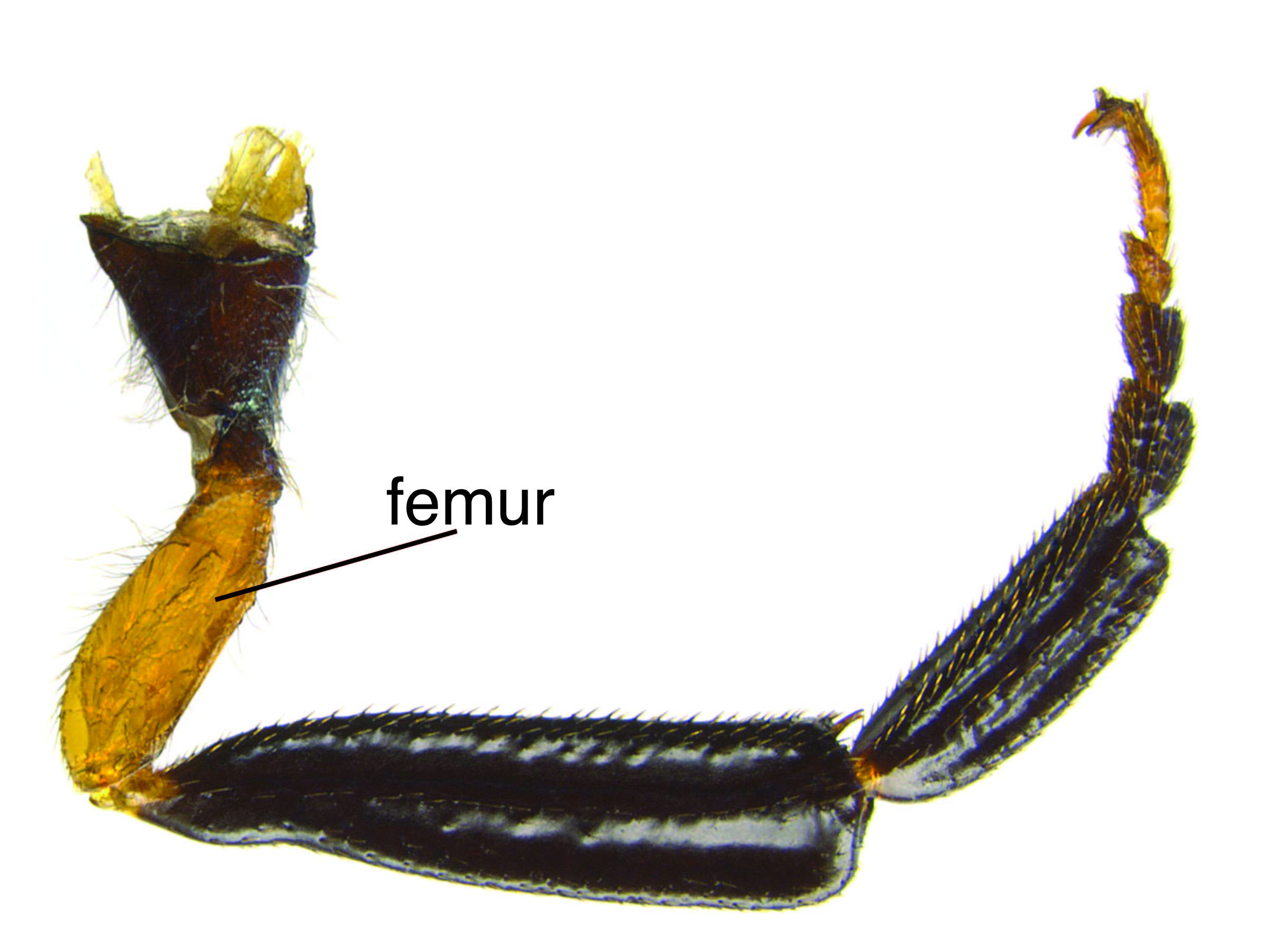 black (Zhelokhovtsev 1994Zhelokhovtsev 1994:
black (Zhelokhovtsev 1994Zhelokhovtsev 1994: sometimes with yellow at the basebase:
sometimes with yellow at the basebase:The simplest way to distinguish S. ermak from similar European species S. juvencus is by range. There is not sufficient information to distinguish S. ermak morphologically from all other all-black species and forms (Smith 1978Smith 1978:
Smith DR. 1978. Suborder Symphyta (Xyelidae, Parachexyelidae, Parapamphiliidae, Xyelydidae, Karatavitidae, Gigasiricidae, Sepulcidae, Pseudosiricidae, Anaxyelidae, Siricidae, Xiphydriidae, Paroryssidae, Xyelotomidae, Blasticotomidae, Pergidae). Hymenopterorum Catalogus 14: 1-193., EPPO 2005EPPO 2005:
EPPO 2005. Sirex ermak . Data sheets on quarantine pests. European and Mediterranean Plant Protection Organization OEPP/EPPO Bulletin 35: 453-455.).
none recorded
Sirex species feed on trees of Pinaceae and Cupressaceae. Sirex ermak is recorded feeding on Larix sibirica (Siberian larch), Larix gmelinii (Dahurian larch), Pinus sibirica (Siberian pine), Pinus spp. (pine), Abies spp. (fir), and Picea spp. (spruce) (Smith 1978Smith 1978:
Smith DR. 1978. Suborder Symphyta (Xyelidae, Parachexyelidae, Parapamphiliidae, Xyelydidae, Karatavitidae, Gigasiricidae, Sepulcidae, Pseudosiricidae, Anaxyelidae, Siricidae, Xiphydriidae, Paroryssidae, Xyelotomidae, Blasticotomidae, Pergidae). Hymenopterorum Catalogus 14: 1-193., Zhelokhovtsev 1994Zhelokhovtsev 1994:
Zhelokhovtsev AN. 1994. Suborder Symphyta (Chalastrogastra). In: Medvedev GS ed. Keys to the insects of the European part of the USSR vol III part 6: 1-387., EPPO 2005EPPO 2005:
EPPO 2005. Sirex ermak . Data sheets on quarantine pests. European and Mediterranean Plant Protection Organization OEPP/EPPO Bulletin 35: 453-455.).
Female Sirex harbor symbiotic basidiomycete fungus in abdominal glands called mycangia. During oviposition, the site is inoculated with the fungus (Amylostereum spp.), which begins to decompose the surrounding wood. LarvaeLarva:
the immature stage of holometabolous insects
 feed on the fungus, and in the process bore galleries through the wood (EPPO 2005EPPO 2005:
feed on the fungus, and in the process bore galleries through the wood (EPPO 2005EPPO 2005:
EPPO 2005. Sirex ermak . Data sheets on quarantine pests. European and Mediterranean Plant Protection Organization OEPP/EPPO Bulletin 35: 453-455., Schiff et al. 2012Schiff et al. 2012:
Schiff NM, Goulet H, Smith DR, Boudreault C, Wilson AD, and Scheffler BE. 2012. Siricidae (Hymenoptera: Symphyta: Siricoidea) of the Western Hemisphere. Canadian Journal of Arthropod Identification 21: 1-305.).
Larvae are creamy white and grub-like in appearance with a dark head capsule. As with adults, larvaelarva:
the immature stage of holometabolous insects
 possess a short dorsaldorsal:
possess a short dorsaldorsal:
of or on the top surface of the body or structure
horn on the posterior end of the body. The larvaelarva:
the immature stage of holometabolous insects
 bore galleries into wood, feeding until pupation and subsequent emergence. Throughout this process, the larvaelarva:
bore galleries into wood, feeding until pupation and subsequent emergence. Throughout this process, the larvaelarva:
the immature stage of holometabolous insects
 use their horn to pack the tunnel behind them with sawdust. Emergence holes are perfectly circular. The fungal symbiont is carried in specialized organs in female larvaelarva:
use their horn to pack the tunnel behind them with sawdust. Emergence holes are perfectly circular. The fungal symbiont is carried in specialized organs in female larvaelarva:
the immature stage of holometabolous insects
 that develop into the mycangia after metamorphosis (Schiff et al. 2012Schiff et al. 2012:
that develop into the mycangia after metamorphosis (Schiff et al. 2012Schiff et al. 2012:
Schiff NM, Goulet H, Smith DR, Boudreault C, Wilson AD, and Scheffler BE. 2012. Siricidae (Hymenoptera: Symphyta: Siricoidea) of the Western Hemisphere. Canadian Journal of Arthropod Identification 21: 1-305.).
The documented flight period of S. ermak is July and August (extending into September in the Far East) (EPPO 2005EPPO 2005:
EPPO 2005. Sirex ermak . Data sheets on quarantine pests. European and Mediterranean Plant Protection Organization OEPP/EPPO Bulletin 35: 453-455.).
Though many Sirex have an apparent preference for dead or partially decaying wood, Sirex ermak has also been recorded feeding on healthy live trees. Reports of infestations of this species in conjunction with a defoliating forest pest can lead to tree deaths after 2–3 years in its range (EPPO 2005EPPO 2005:
EPPO 2005. Sirex ermak . Data sheets on quarantine pests. European and Mediterranean Plant Protection Organization OEPP/EPPO Bulletin 35: 453-455.).
World: Sirex ermak is found in Siberia, Transbaikalia, and the Far East of Russia, and in the Qinghai province of China (Smith 1978Smith 1978:
Smith DR. 1978. Suborder Symphyta (Xyelidae, Parachexyelidae, Parapamphiliidae, Xyelydidae, Karatavitidae, Gigasiricidae, Sepulcidae, Pseudosiricidae, Anaxyelidae, Siricidae, Xiphydriidae, Paroryssidae, Xyelotomidae, Blasticotomidae, Pergidae). Hymenopterorum Catalogus 14: 1-193., Xiao and Wu 1983Xiao and Wu 1983:
Xiao G and Jian W. 1983. The siricid wood wasps of China (Hymenoptera, Symphyta). Scientia Silvae Sinicae Memoirs of Forest Entomology 8: 1-29., EPPO 2005EPPO 2005:
EPPO 2005. Sirex ermak . Data sheets on quarantine pests. European and Mediterranean Plant Protection Organization OEPP/EPPO Bulletin 35: 453-455.).
North America: not recorded
Map data from: GBIF.org (26 June 2019) GBIF Occurrence Download Sirex ermak
Details about data used for maps can be found here.